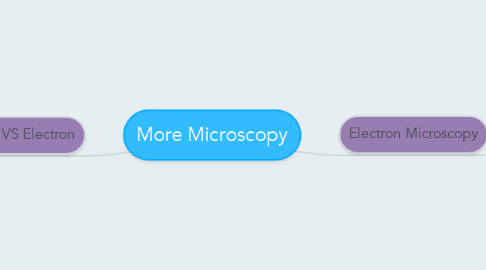
1. Electron Microscopy
1.1. A beam of electrons with a wave length of less than 1nm is used to illuminate the specimen. More detail can be seen because electrons have a much smaller wave length than light waves. They can produce images with magnifications of up to X500,000 and still have clear resolution.
1.1.1. They have changed the way we understand cells.
1.2. However, there are some disadvantages.
1.2.1. They are very expensive.
1.2.2. They take up a lot of room and need a dedicated space.
1.2.3. Specimens can be damaged by the electron beam.
1.2.4. It takes a lot of skill and training to prepare a specimen.
1.2.5. Specimens have to be dead, can't analyse living organisms.
1.2.6. Requires a vacuum.
1.3. Transmission Electron Microscope (TEM)
1.3.1. A beam of electrons are transmitted through a specimen and focused to produce a 2 dimensional image. They have the best resolving power of 0.5nm.
1.4. Scanning Electron Microscope (SEM)
1.4.1. A beam of electrons are sent across the surface of a specimen and the reflected electrons are collected. The resolving power is from 3-10nm. The image formed is £ dimensional and give valuable information about the appearance of different organisms.
1.5. Sample Preparation
1.5.1. Inside an electron microscope is a vacuum to ensure the electron beams travel in straight lines. Due to this, samples have to be prepared in a certain way.
1.5.2. Specimen preparation involves fixation using chemicals or freezing, staining with heavy metals and dehydration with solvents. Samples for TEM will then be set in resin and may be stained again. SEM samples may be fractured to expose the inside, then be coated with a heavy metal.
2. Light VS Electron
2.1. Light
2.1.1. Inexpensive to buy and operate
2.1.2. Small and portable
2.1.3. Simple sample preparation
2.1.4. Sample isn't damaged by preparation
2.1.5. Vacuum is not required
2.1.6. Gives a coloured image
2.1.7. Up to X2000 magnification
2.1.8. Resolving power is 200nm
2.1.9. Specimens can be living or dead
2.2. Electron
2.2.1. Expensive to buy and operate
2.2.2. large in size and needs to be installed
2.2.3. complex sample preparation
2.2.4. Vacuum is required
2.2.5. Produces black and white images
2.2.6. over X500,000 magnification
2.2.7. Resolving power of TEM is 0.5nm and SEM is 3-10nm
2.2.8. Specimens have to be dead

